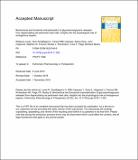Files in this item
Biochemical and functional characterization of glycosaminoglycans released from degranulating rat peritoneal mast cells: insights into the physiological role of endogenous heparin
Item metadata
| dc.contributor.author | Lever, Rebecca | |
| dc.contributor.author | Smailbegovic, Amir | |
| dc.contributor.author | Riffo-Vasquez, Yanira | |
| dc.contributor.author | Gray, Elaine | |
| dc.contributor.author | Hogwood, John | |
| dc.contributor.author | Francis, Stephen M. | |
| dc.contributor.author | Richardson, Neville V. | |
| dc.contributor.author | Page, Clive P. | |
| dc.contributor.author | Mulloy, Barbara | |
| dc.date.accessioned | 2017-11-06T08:46:27Z | |
| dc.date.available | 2017-11-06T08:46:27Z | |
| dc.date.issued | 2016-12 | |
| dc.identifier | 247455707 | |
| dc.identifier | 57c043e3-214c-4f9c-a855-f7bdb352f968 | |
| dc.identifier | 84996483315 | |
| dc.identifier | 000390515100011 | |
| dc.identifier.citation | Lever , R , Smailbegovic , A , Riffo-Vasquez , Y , Gray , E , Hogwood , J , Francis , S M , Richardson , N V , Page , C P & Mulloy , B 2016 , ' Biochemical and functional characterization of glycosaminoglycans released from degranulating rat peritoneal mast cells: insights into the physiological role of endogenous heparin ' , Pulmonary Pharmacology & Therapeutics , vol. 41 , pp. 96-102 . https://doi.org/10.1016/j.pupt.2016.11.002 | en |
| dc.identifier.issn | 1094-5539 | |
| dc.identifier.other | RIS: urn:A1C9CACA43B06C5B1F5025D1CDBB09F6 | |
| dc.identifier.uri | https://hdl.handle.net/10023/11991 | |
| dc.description | We acknowledge the support of the Wellcome Trust for a grant to RL, CPP and NVR to support some of this work. | en |
| dc.description.abstract | The properties of commercially prepared heparin as an anticoagulant and antithrombotic agent in medicine are better understood than is the physiological role of heparin in its native form, where it is uniquely found in the secretory granules of mast cells. In the present study we have isolated and characterised the glycosaminoglycans (GAGs) released from degranulating rat peritoneal mast cells. Analysis of the GAGs by NMR spectroscopy showed the presence of both heparin and the galactosaminoglycan dermatan sulphate; heparinase digestion profiles and measurements of anticoagulant activity were consistent with this finding. The rat peritoneal mast cell GAGs significantly inhibited accumulation of leukocytes in the rat peritoneal cavity in response to IL-1β (p < 0.05, n = 6/group), and inhibited adhesion and diapedesis of leukocytes in the inflamed rat cremasteric microcirculation in response to LPS (p < 0.001, n = 4/group). FTIR spectra of human umbilical vein endothelial cells (HUVECs) were altered by treatment of the cells with heparin degrading enzymes, and restored by the addition of exogenous heparin. In conclusion, we have shown that rat peritoneal mast cells contain a mixture of GAGs that possess anticoagulant and anti-inflammatory properties. | |
| dc.format.extent | 7 | |
| dc.format.extent | 1655830 | |
| dc.language.iso | eng | |
| dc.relation.ispartof | Pulmonary Pharmacology & Therapeutics | en |
| dc.subject | Heparin | en |
| dc.subject | Mast cells | en |
| dc.subject | Dermatan sulphate | en |
| dc.subject | Glycosaminoglycan | en |
| dc.subject | QD Chemistry | en |
| dc.subject | RM Therapeutics. Pharmacology | en |
| dc.subject | NDAS | en |
| dc.subject | SDG 3 - Good Health and Well-being | en |
| dc.subject.lcc | QD | en |
| dc.subject.lcc | RM | en |
| dc.title | Biochemical and functional characterization of glycosaminoglycans released from degranulating rat peritoneal mast cells: insights into the physiological role of endogenous heparin | en |
| dc.type | Journal article | en |
| dc.contributor.sponsor | The Wellcome Trust | en |
| dc.contributor.institution | University of St Andrews. School of Chemistry | en |
| dc.contributor.institution | University of St Andrews. EaSTCHEM | en |
| dc.identifier.doi | https://doi.org/10.1016/j.pupt.2016.11.002 | |
| dc.description.status | Peer reviewed | en |
| dc.date.embargoedUntil | 2017-11-03 | |
| dc.identifier.grantnumber | 072162/Z/03/Z | en |
This item appears in the following Collection(s)
Items in the St Andrews Research Repository are protected by copyright, with all rights reserved, unless otherwise indicated.

